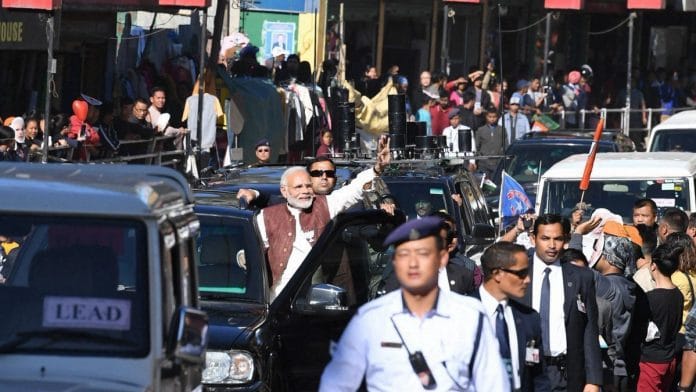Mizoram assembly elections prove that normalisation of electoral process roots out insurgency.
On 5 March, 1966, four fighter jets of the Indian Air Force were deployed to bomb Aizawl, now the capital of Mizoram. Rebels had taken control of the city, and the orders from New Delhi were to regain the lost territories. It was the first raid with fighter jets by the Air Force on a civilian area in India. As Mizoram votes Wednesday to elect its seventh state legislative assembly after getting full statehood in 1987, it is imperative to revisit the history of this rebellion.
Does normalising of the electoral process in Mizoram, rather than counter-insurgency campaigns, hold any lesson for reducing violence in other insurgency-affected areas in India and elsewhere?
The Mizo rebellion began in the late 1950s when Mizoram was still a part of Assam. The Indian government’s failure to provide relief during a widespread famine and the high-handedness by the security forces in dealing with protestors led to an open rebellion. The Mizo National Front (MNF) under Laldenga led this rebellion. They organised an armed insurgency – Operation Jericho – against the Indian state and attacked Army barracks at Aizawl and Lunglei on 28 February, 1966.
Also read: State elections are bad news for BJP and not good news for Congress either
In addition to the air-strikes, the Indian Army deployed few columns. The Armed Forces (Special Powers) Act (AFSPA) was in force in the area by 1967. Although this effort succeeded in clearing Aizawl and the neighbouring regions from rebels, it could not root out the insurgency. The insurgents retreated into the villages and jungles (and in the border areas of Myanmar and Bangladesh) and continued with their activities for nearly two decades.
In 1986, Prime Minister Rajiv Gandhi signed the Mizoram Peace Accord with leaders of the Mizo National Front (MNF). The accord mandated full statehood to Mizoram, immediate dissolution of the state assembly and call for fresh elections, and that the MNF would lay down arms and participate in the democratic process as a political party.
The MNF won the 1987 assembly elections and Pu Laldenga was sworn as the chief minister. However, a little over a year into power, Laldenga’s government fell short of the majority in the house as 8 of the 25 MNF MLAs defected to the Congress, and this led to the imposition of President’s Rule in the state. The Congress returned to power after the 1989 polls and continued its winning streak in the 1993 elections. The two opposition parties, the MNF and the Mizoram People’s Conference (MPC), formed a pre-poll alliance and won in the 1998 Assembly elections. MNF leader Zoramthanga (Laldenga’s successor) was sworn in as the new chief minister and the party won the next round of elections in 2003.
Also read: India and Myanmar quietly open up their border for villagers and trade
In the two decades since the signing of the Mizo accord, the rebels got accommodated at various levels. Party politics in Mizoram was normalised with Congress and the MNF becoming two poles of the state’s politics despite new players entering the scene in every election. The Congress returned to power in 2008, and five years later, it was voted back with even a higher vote and seat share in the state assembly.
The data presented in Table 1 and Figure 1 helps in making three broad points.
Table 1: Vote share of various parties in Mizoram assembly elections (in %)

Figure 1: Seat share of various parties in Mizoram assembly elections (in %)

First, the Congress party in the past decade has managed to strengthen its position in Mizoram. The party’s vote share has continuously increased in past three elections. Second, the MNF’s vote share has remained stable, and the vote share of Mizo People’s Congress (MPC) has plummeted with each successive election. Third, there is huge vote-seat disproportionality in Mizoram. The party that leads in vote share (even with few points) ends up winning most of the seats. For example, the Congress in the last two elections won more than 80 per cent of seats.
What does this mean for the 2018 assembly elections? For starters, the game is wide open. Although the Congress had a substantial lead over the MNF in the previous poll, we may see a multi-polar contest in many seats this time due to the presence of two additional players. A coalition of seven parties (which includes the Mizo People’s Congress and the Zoram Nationalist Party) and a resurgent BJP will ensure that the winning margins across many seats are going to be very low. This may make Congress’s return for a third consecutive term a bit difficult.
Also read: Citing ISIS, Rahul says exclusion of people from development process leads to insurgency
Moreover, the BJP’s aggressive push across northeastern states indicates that even if the party fails to make a big impression on its own in the state, it may have a say in government formation if the MNF fails to secure a majority on its own.
In some sense, the most significant message from Mizoram on 11 December should not be about deciphering the national mood or emerging trend in northeastern states. What we should rather learn from the Mizoram example is a lesson in how normalisation of electoral process slowly eliminates secessionist sentiments from the population. This lesson becomes especially critical in the context of ongoing conflicts in the Naxal-affected Red corridor and militancy in Kashmir.
The author is a PhD candidate in political science at the University of California at Berkeley, US.






